In Search of a Red-throated Loon
At the end of the beach, surrounded by calm water, enjoying the spring sea ducks while hoping for a red-throated loon.
Arriving at my favorite winter birding spot, I climbed out of my car and gathered my binoculars and spotting scope. The morning was calm and clear with temperatures in the low 20s, so still that I could hear the calls of the common eider that were densely packed in the channel. Rain and ice have eroded the trail to the beach, and repeated winter storms have torn out the ramp and left only rough slick rocks to traverse. It was a slack low tide, that brief time when the tide is at its lowest point and the tidal currents have ceased. The beach was smooth after the scouring of last night’s high tide and a light frost sparkled on the damp sand. The first rays of the rising sun were reflecting off the water and onto the bridge supports, somehow making the crumbling concrete attractive.
I paused to scan the water for initial impressions and bird sightings. Looking under the bridge and across the open bay I saw several common loons, notable for their large size, dark bodies, and thick long bills. Common loons are present almost everywhere in salt water this time of year; I love to watch them cruise the water and sink effortlessly below the surface when hunting for prey. As always, I gave each loon a careful look to see if it might be a red-throated loon, as they are generally less common here and therefore hold extra appeal when found. The smaller red-throated loons are slimmer and more sinuous with light gray coloring that blends effortlessly with winter waters. The eponymous breeding plumage does not appear until late spring during migration. There were numerous loons scattered about today, so far all common. A few of the loons had plumage that was starting to change from the dark gray of winter to the black of breeding season, making them stand out even more clearly on the calm water reflecting the brightening sky above.
The beach here is ephemeral, raised high during low tide but then quickly reclaimed by the returning water. An enjoyable meditation exercise is to stand at the end of the beach as the tide returns, watching the overlapping small waves from each side of the narrow beach steadily cover more sand, forcing the observer to make a slow retreat. One has to be careful to watch the path behind, as I have been cut off more than once as the tide covers a low point midway down the beach. I walked along the sand on the crest of the beach where the sand had been rippled by the action of waves and currents of the last high tide. At the end of the spit I stopped, set up my spotting scope, and started to look for birds on the water and sandbars. Almost immediately a herring gull pulled a clam from the muddy tidal flats and carried it to an open area behind me. The gull repeatedly lifted up several feet into the air and dropped the clam onto a rock to crack it open, the early light highlighting the bird’s pure white feathers against the dark background.
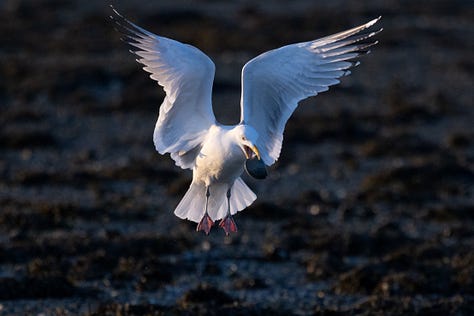
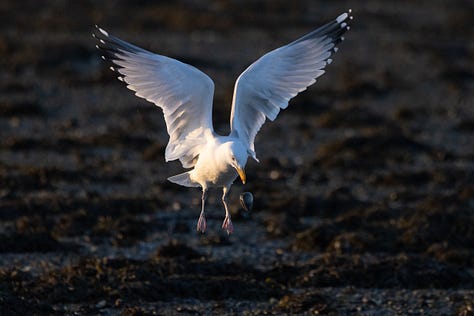

I heard the whistles of a bald eagle and looked about in vain to find it. The distinctive call is rather weak and does not do justice to the size and grandeur of the massive raptor. I could localize the sound to the wood line across the mudflats but the sun was rising directly behind the area and it was impossible to make out details. The eagle was likely perched out of sight for if it were flying then the ducks and gulls would launch en masse from the water, sandbars, and mudflats to avoid the risk of being caught. There is a long, curved sandbar that appears at low tide in the middle of the water and creates two channels. When the tide is changing, the current flows around both sides of the sandbar and any birds will slowly move with the tide. Today there were hundreds of seabirds that seemed to favor the channel on the far side of the low sandbar and the water just along the near side. Numerous gulls covered the sandbar and a hunting pack of red-breasted mergansers surfaced to the right of the long sandbar. The birds were energized and dove repeatedly, presumably in pursuit of a school of small fish.
Invigorated by the lengthening days, dozens of eiders, goldeneyes, and buffleheads were displaying and calling. The mellow cooing from the male eiders filled the air as I watched the striking males with their black and white plumage stretch their necks upwards and back, rearing up out of the water enough to show their black bellies. The male goldeneyes tossed their heads until they were almost touching their back, their bills pointing toward the sky while given a brief peent call. I heard the calls off and on throughout my stay, but only a few times did I actually see the males displaying. The male buffleheads were activated when in small groups, chasing each other, making short flights to skid across the surface of the water with their breasts puffed out. This morning, pairs of buffleheads flew past close enough to let me see clearly the shiny iridescence of the male’s head, the flashing white patches on the dark wings, and the incongruous trailing pink legs and feet.
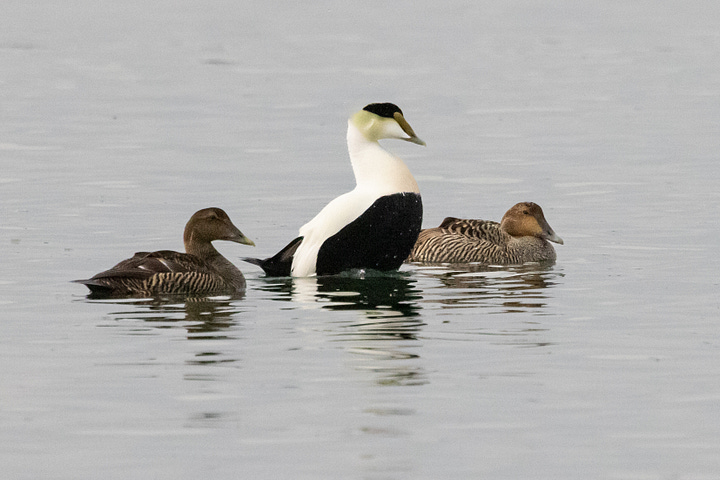
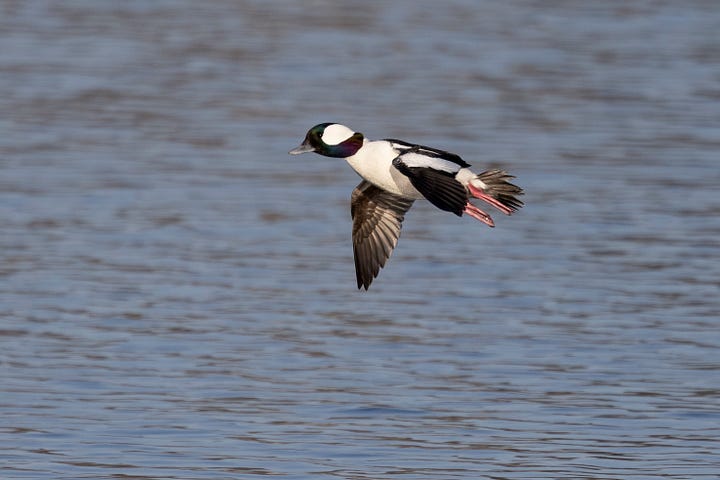
I noticed something white floating on the calm water. At first I assumed it was a buoy that had broken free from its mooring. I looked more closely through binoculars and saw it was a dead bird. It was hard to make out details beyond the brilliant white of the belly, even size was challenging without the context of another bird. The tidal current was starting to move to the right and the bird slowly floated past and rotated to reveal more details. It was lying on its left side with the head pointing to the right and facing me. I could see a white throat and face, the visible nape and crown were gray, the eye was closed, and the bill was partially underwater. It was a red-throated loon, but not the sighting I had hoped. I wondered if it was flying across the bridge this morning and hit the power lines, something that others have witnessed several seabird species do in the past. I was transfixed by the loon, by its quiet repose that resembled slumber more than death. I studied the smooth plumage along the belly and wings, the large foot extended back as if in a stretch. The slender bill held at an upward angle is a key field mark when the bird is sitting on the water. I studied the bill that now tipped down under the smooth water, no longer in use, no longer leading the way as the loon leapt into the air in a graceful dive underwater to hunt.
I picked up my scope and turned back toward the bridge. As I walked along three buffleheads stopped their displays and ran along the water until they were airborne. A pair of long-tailed ducks opened their wings and dove beneath the water. Another flock of eiders was drifting off to my right and I watched with my naked eye the displaying and cooing males and the indifferent females. I paused once more at the base of the beach, raising my binoculars to pick out the dead loon passing now around the end of the beach. At some point the eagle may notice it and swoop down and carry it off to the sandbar or the dead branch of a tall pine. For now, the loon was intact and at rest, flowing with the incoming tide toward the open water.

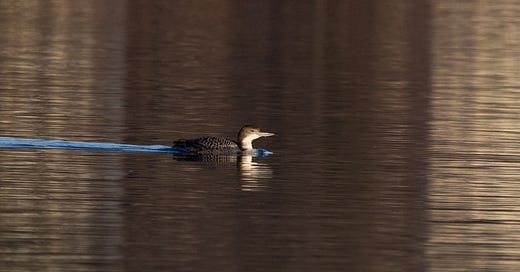




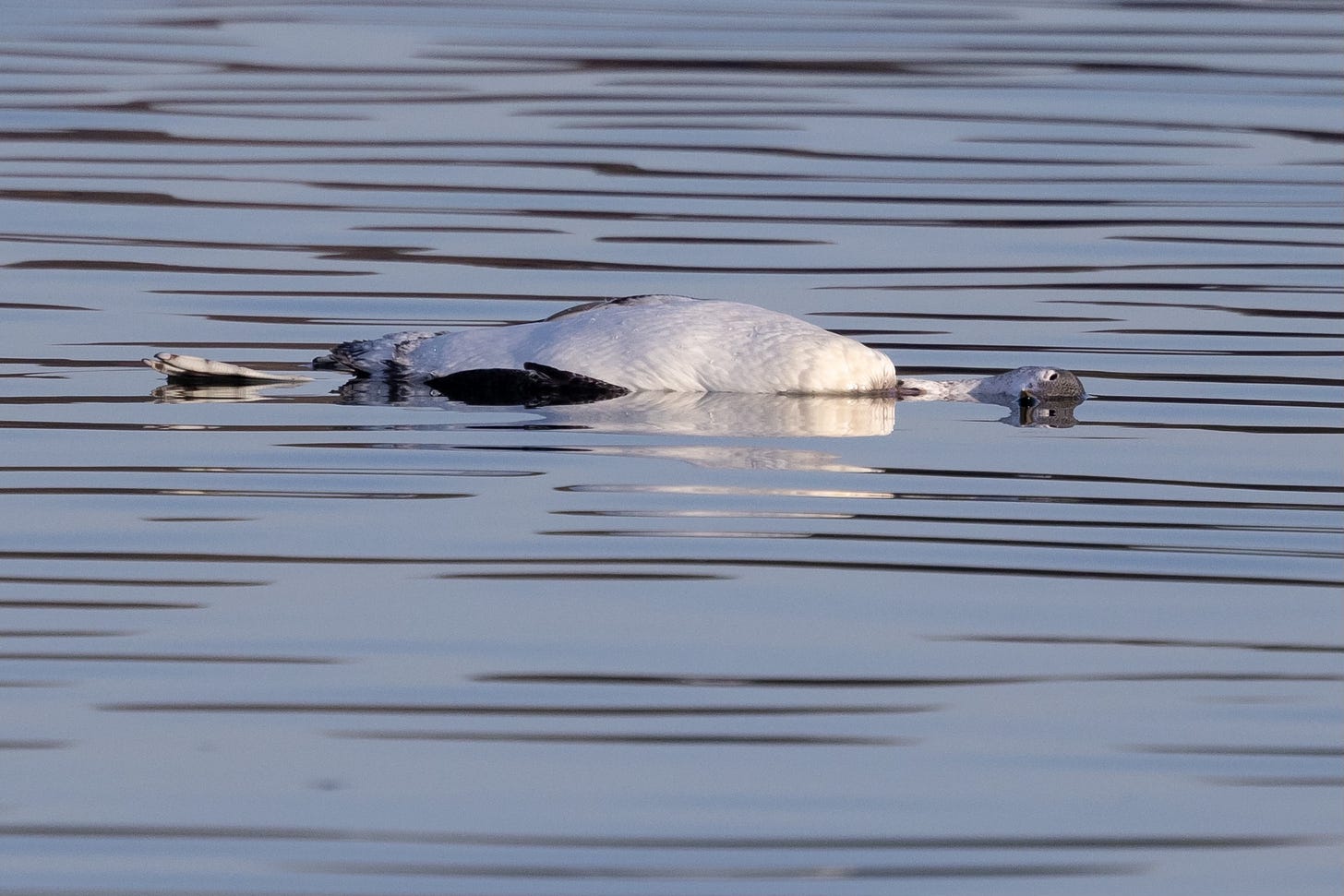
Beautiful writing and photos. The subtle elation of realizing a Loon is Red-throated rather than Common is a special feeling.
Excellent photographs and beautifully written text.